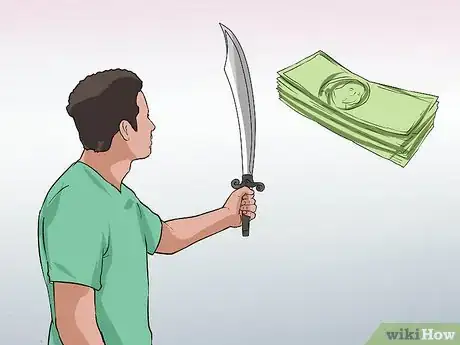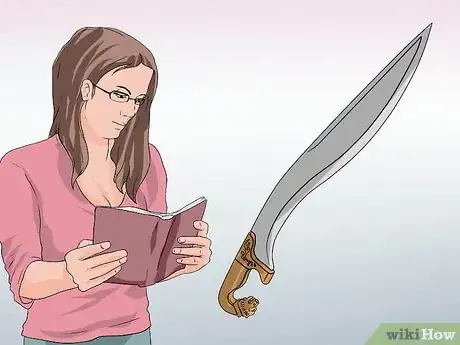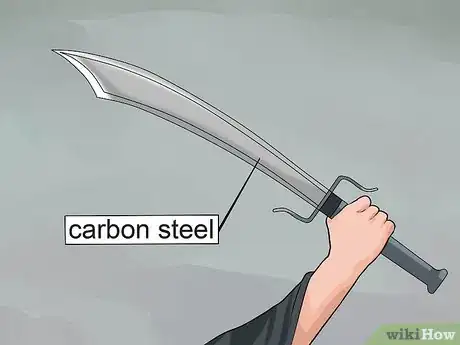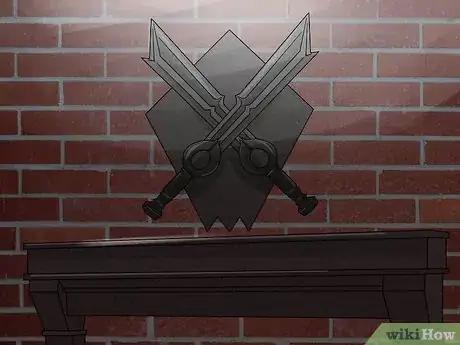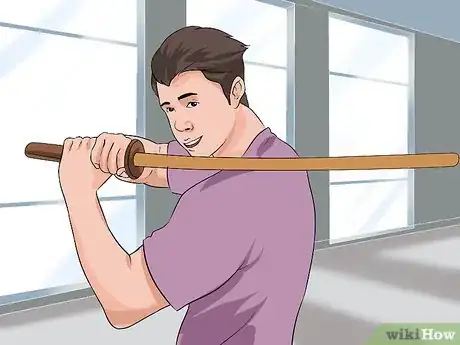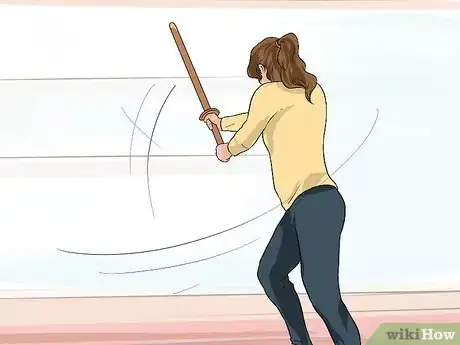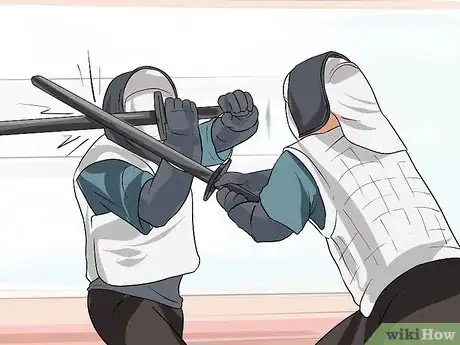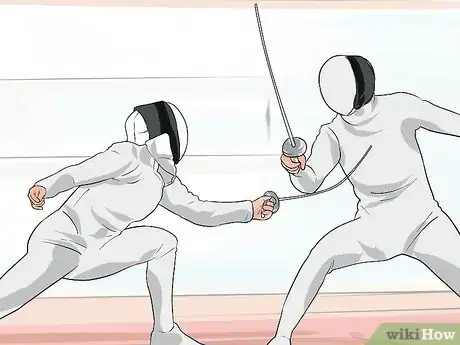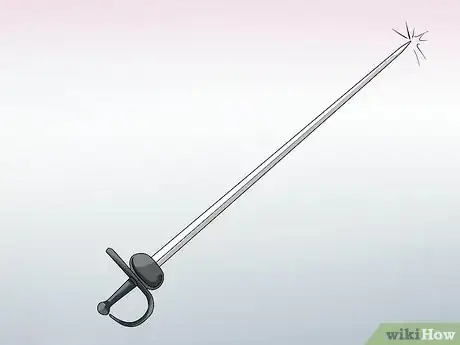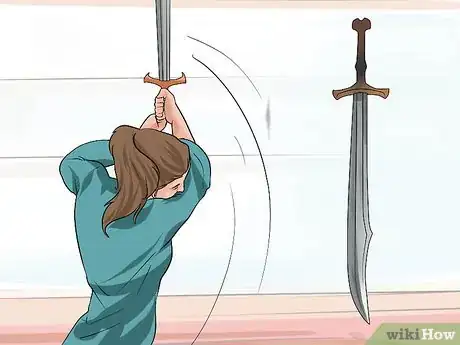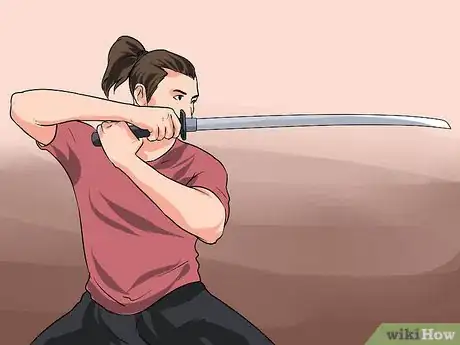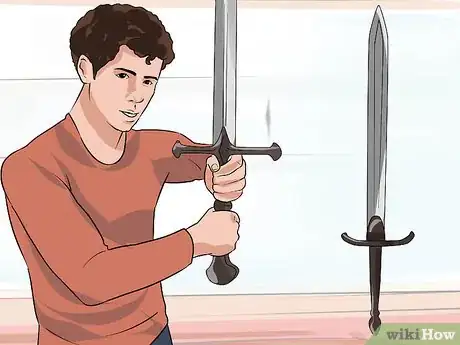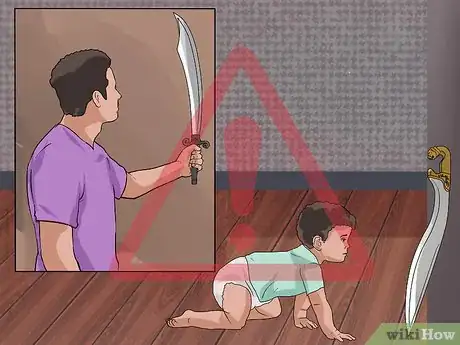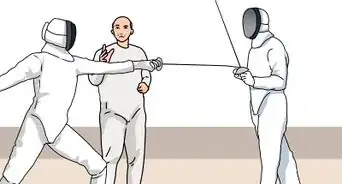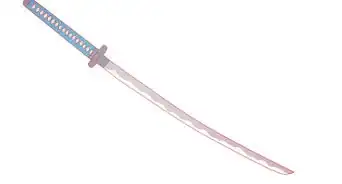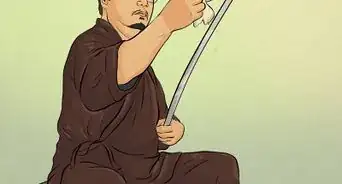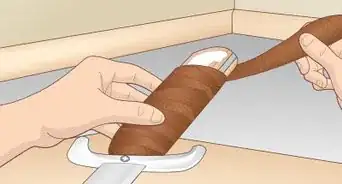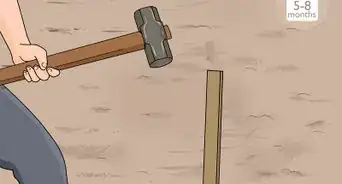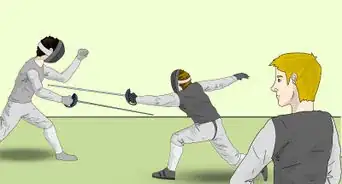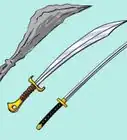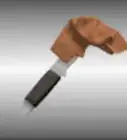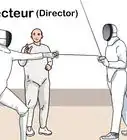This article was co-authored by wikiHow staff writer, Amber Crain. Amber Crain has been a member of wikiHow’s writing staff for the last six years. She graduated from the University of Houston where she majored in Classical Studies and minored in Painting. Before coming to wikiHow, she worked in a variety of industries including marketing, education, and music journalism. She's been a radio DJ for 10+ years and currently DJs a biweekly music program on the award-winning internet radio station DKFM. Her work at wikiHow supports her lifelong passion for learning and her belief that knowledge belongs to anyone who desires to seek it.
There are 13 references cited in this article, which can be found at the bottom of the page.
This article has been viewed 89,075 times.
Learn more...
Sword designs vary widely, with each design featuring unique characteristics that perform completely different functions. Because of this, many people aren’t sure how to choose the right sword for their purposes. Armed with a little knowledge and a few pointers, you can confidently go about choosing the right sword for you.
Steps
Choosing a Sword for Decoration
-
1Stick to a budget with a non-tempered sword. Tempered blades have been crafted a particular way so that they can be very finely sharpened and withstand the force of combat. They are considered to be functional, battle-ready weapons.[1] They are also extremely expensive, especially those with historical designs, with prices ranging anywhere from $500 to several thousands of dollars.[2]
- Unless you are a serious collector or a purist, go with a non-tempered sword.
- These are far more affordable and look just as great hanging on your wall.
-
2Be historically accurate but safe with a non-functional replica. Many collectors and enthusiasts want a sword that is historically accurate for decorative purposes. However, just because it’s ornamental doesn’t mean it can’t be used, and whenever a sword is within reach it poses a potential danger, especially if you have children in the house.
- The answer to this predicament is a non-functional replica based on a historical design.[3]
- These look great, but they're not usable. The blades are dull, the swords are lightweight and the designs are too flimsy to withstand any kind of force.
Advertisement -
3Buy an authenticated, historical sword if you're a history buff. Authentic swords are available to be purchased, although the price tags on them are usually rather steep. However, if you have the money, these are a fantastic collector's item. Do your research before you commit to buying a historical sword to make sure you are getting the real deal.
- Many establishments or private sellers will provide certificates of authenticity.
- If the sword you have your eye on doesn't come with one of these certificates, ask why.
-
4Decorate with fantasy swords based on fictional descriptions.[4] Fantasy swords are modern swords that are not based on historical designs. They are either completely original designs or they are based on descriptions pulled from literature and other works of art. These swords look great on the wall and are relatively affordable.
- For example, you can easily obtain a fantasy replica of Frodo’s sword Sting from the Lord of the Rings trilogy.[5]
- A huge range of other options are also available, especially online.
-
5Get a blade made of carbon steel if you want to occasionally use it. Some people want a mostly-decorative sword that can be taken down from the wall and used, if the owner so chooses. These swords are called functional swords – they are battle-ready and forged like real weapons. These tend to be on the pricier side, but the quality is generally quite high.
- Functional swords may come with blades that are sharpened, others may not. Be sure to find out from the manufacturer.
- If a functional blade does comes unsharpened, you can easily sharpen it yourself. It is a real weapon. However, if you’re concerned about safety, leave the blades dull.
-
6Display your decorative sword safely. Swords are extremely dangerous and should be handled and displayed with extreme caution. If you are doing a wall mount, consider mounting the sword high enough so that it can't be reached (especially by children).
- A wall mount with a glass case enclosure is the ideal way to hang an ornamental sword.
- Even if you don't have small children, speak to everyone in your home about safety around the sword.
Selecting a Sword for Training
-
1Train safely as a beginner with a wooden sword.[6] Actual swords are extremely sharp and not meant for training because the risk of injury is too great. Throughout history, all sword-wielding cultures have trained and sparred with wooden swords. The two most popular kinds are the bokken (used in Eastern martial arts, and properly called a bokuto in Japan) and the waster (used in Western martial arts).
- As a beginner, start off with a relatively inexpensive wooden sword made of bamboo or any other type of lightweight wood.
- Choose one with a well-crafted handle and guard to ensure that the sword fits securely in your hand.
-
2Use a sword made of hickory for intermediate to advanced training. Because of its toughness and durability, a hickory-crafted sword is the preferred training tool for the serious swords collector. Also, hickory is a heavy wood, so swords made of it are closer to the weight of an actual sword.[7]
- Synthetic wooden swords made of heavy grade polypropylene are also great for serious training because of their extreme durability.
- These synthetic versions are not as stiff as their wooden counterparts.[8]
-
3Focus on technique with a lightweight sword. The weight of an actual sword can hinder your training by restricting range of motion. Test for a lighter, more ideal weight by holding the practice sword in your dominant hand for about ten minutes. If you don’t feel any discomfort in your arm during that time period, the practice sword is light enough for your training purposes.
- Move the sword around a bit and try a few practice thrusts. You should be able to manipulate the sword easily without straining any of your arm muscles.
- Make sure the practice sword features a blade that is dull (to prevent injury) and somewhat flexible.[9]
-
4Use a foam or padded sword for intense training with minimal armor.[10] If you want to train in an aggressive fighting style or if you simply don’t want to wear a lot of training armor, a foam or padded sword is the perfect choice for you. These make great training tools because they allow you to engage aggressively while sparring, offering a more realistic combat experience.
- Minimal armor is required, but keep in mind that foam swords can still be a little painful when used at full force.
- Minimal armor in this case would be a helmet and groin protection.
-
5Select a blunted steel sword for advanced training with a partner.[11] For the experienced swordsman who engages in intense training with steel on steel contact, the blunted steel sword is the ideal choice. They closely approximate a real sword in almost every way, but the possibility of injury is greatly diminished.
- When training with blunted steel tools, armor should always be worn.
- An inexperienced user should not wield one of these, since they can be dangerous.
Selecting a Sword for Combat
-
1Choose a foil if you're an energetic, sharp-witted fencer. Foil fencing requires rapid reflexes and lots of endurance. There is only one way to score in foil fencing - by touching an opponent's torso with the foil. Because the torso is such a limited portion of the body, opponents usually engage with one another in close quarters and the foil requires almost non-stop movement during combat.
- In general, the foil is best wielded by an athlete who is shorter than average.
- The foil offers lively, engaging combat for those who are nimble and can think very fast on their feet.[12]
-
2Use a rapier if you prefer a cut-and-thrust technique in combat. Rapiers have long, narrow blades that are ideal for an offensive cut-and-thrust style of fighting. The edges of a rapier aren’t that sharp, since the emphasis is on the pointed tip rather than the blade itself. They can slash and slice to some extent, but their main purpose was for lunging and thrusting.
- Details can vary from rapier to rapier, but in general these swords are thin, lightweight and intended for unarmored single-combat.
- Rapiers were originally Medieval swords used by both the military and civilians.[13]
-
3Slash and slice with the curved blade of the falchion, scimitar or sabre. These swords originate from different time periods and cultures, but all of them feature a curved blade with a single sharpened edge meant for violent combat. They were sharp enough to slice off the limbs and head of an opponent in a single stroke.[14]
- These blades could be used for combat in close quarters and also worked well if you were on horseback.
- Even when wielded by an unskilled swordsperson, these swords could cut through most armor and inflict massive damage and deadly wounds.[15]
-
4Use the long, deadly blade of the katana for outdoor combat. The katana was one of the sacred swords of the Samurai. It features a long, extremely strong blade that is best used in combat on an open battlefield rather than close in close quarters. It was equally effective when fighting on the ground as it was on horseback.
- The blade of the katana is slightly curved, single edged and usually at least 24 inches in length.
- Katana are some of the most revered swords ever to have been forged, made of very durable, high quality steel. They were and still are considered works of art.
-
5Deliver a lethal blow with the force of a two-handed longsword. These Medieval swords featured long grips that allowed the swordsman to wield it with both hands. The blade was usually double-edged and quite long, but the sword itself wasn’t overly heavy, so it was a very versatile weapon that could be maneuvered quickly and easily.
- The longsword could slice, slash, cut and thrust with lethal force.[16]
- Wielding a sword with both hands on the hilt allowed the swordsperson to deliver very powerful blows.
-
6Exercise extreme caution when wielding a sword. All martial arts can be dangerous, but the sword is particularly hazardous because of the sharpness of the blade. Train with good instructors and always handle your sword with the utmost attentiveness. One mistake could result in severe injury and even death.
- Always keep your sword stowed somewhere safe when not in use.
- Small children should never have access to your sword in the house.
Community Q&A
-
QuestionWhat swords would be used for dual wielding?
 Community AnswerShorter blades are better for dual wielding. It is easy to trip yourself up with two long blades. Personally I would recommend either two smaller blades or one long blade and one short blade.
Community AnswerShorter blades are better for dual wielding. It is easy to trip yourself up with two long blades. Personally I would recommend either two smaller blades or one long blade and one short blade. -
QuestionWhat type of sword should I get if I want a long sword that also allows me to slash and lunge?
 Community AnswerTry a two-handed longsword. The longsword could slice, slash, cut and thrust with lethal force. The blade was usually double-edged and quite long, but the sword itself wasn’t overly heavy, so it was a very versatile weapon that could be maneuvered quickly and easily.
Community AnswerTry a two-handed longsword. The longsword could slice, slash, cut and thrust with lethal force. The blade was usually double-edged and quite long, but the sword itself wasn’t overly heavy, so it was a very versatile weapon that could be maneuvered quickly and easily. -
QuestionIs it possible to dual wield Katana?
 Community AnswerYes, it is possible. But usually, the second Katana has a shorter blade, and is called a daishō.
Community AnswerYes, it is possible. But usually, the second Katana has a shorter blade, and is called a daishō.
Warnings
- These weapons, real or not, may be illegal in your area. Check with local law enforcement before purchasing or displaying in public.⧼thumbs_response⧽
- Avoid using decorative swords for practice. Decorative weapons are never capable of enduring the stress of practice. They may break or shatter, causing serious injury or death. Be sure to check whether or not it is full tang and made of decent tempered steel, so that it will not break or warp when you swing it.⧼thumbs_response⧽
- Employ common sense and always handle a sword carefully.⧼thumbs_response⧽
- Use adequate protection when using rebated practice swords. Gloves (such as those intended for lacrosse or cricket) and a fencing mask are minimum protection but with steel blunts you should aim for full body protection.⧼thumbs_response⧽
References
- ↑ http://www.strongblade.com/nav/swords.html
- ↑ http://www.medieval-fightclub.com/pages/Choosing-a-sword.html
- ↑ http://www.thearma.org/Replicas.htm#.V3RhKTVKKec
- ↑ http://www.thearma.org/Replicas.htm#.V3RhKTVKKec
- ↑ http://www.strongblade.com/nav/swords-fantasy.html
- ↑ http://www.sword-buyers-guide.com/sword-fighting.html
- ↑ http://www.woodenswords.com/help_answer.asp?ID=22#272
- ↑ http://www.by-the-sword.com/p-13133-bokken-synthetic-training-sword-26-803638.aspx
- ↑ http://taichiforhealthinstitute.org/faqs/#sword
- ↑ http://www.sword-buyers-guide.com/sword-fighting.html
- ↑ http://www.sword-buyers-guide.com/sword-fighting.html
- ↑ http://www.libertyfencingclub.com/how-to-choose-your-weapon/
- ↑ http://www.thearma.org/Youth/rapieroutline.htm#.V3RG9jVKKec
- ↑ http://www.medieval-life-and-times.info/medieval-swords-and-armor/scimitar-sword.htm
- ↑ http://www.sword-buyers-guide.com/scimitars.html
- ↑ http://www.medievalwarfare.info/weapons.htm
